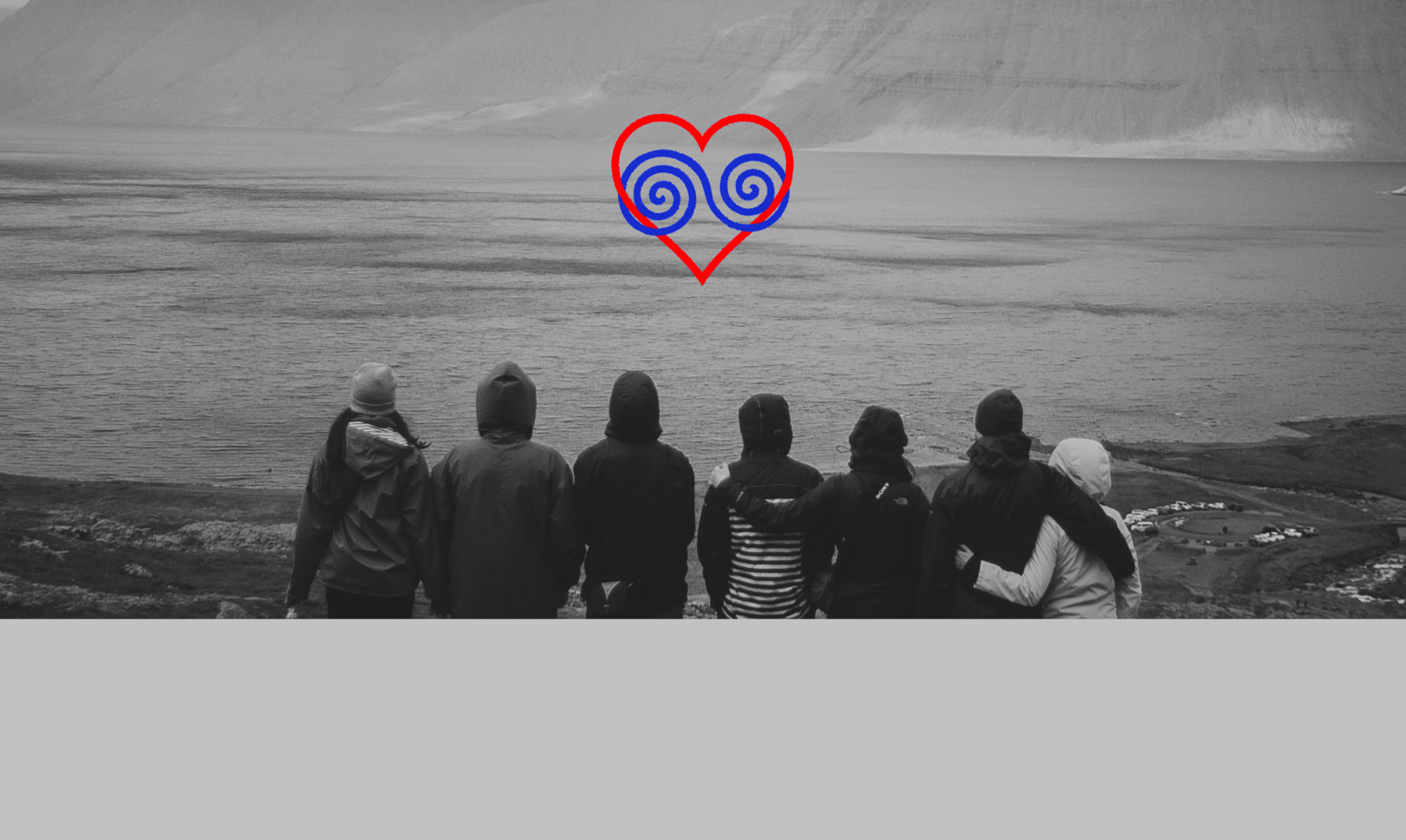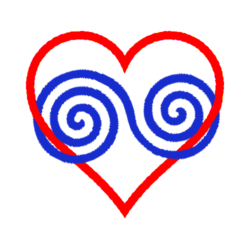The Oligoamorist’s Stone
One day, approximately in the middle of the island, I came across a huge half-sunken and somewhat overgrown stone. Nevertheless, I was able to make out quite clear several words and symbols in the language of the local natives on its surface. Immediately I started to decipher them curiously. In doing so I realised that in this place many a hand had gathered the values of Oligoamory. Among the criteria I already had knowledge of based on my journeys on the archipelago of Polyamory, I discovered to my surprise so far quite unfamiliar terms as well as impressions I had never seen before.

At this place I want to share my personal transcription of the retrieved features with you:
1) At first a symbol caught my eye, which seemed familiar to me for quite a long time. “Oh, but that is ‘responsibility’ “, I initially thought, “I know it already from the otherwisely barely regulated continent of open relationships!”And I was quite able to grasp the meaning of that term, since it was of utmost requirement to any non-monogamous relationship to act responsible concerning personal conduct relating to other potential mates. “But of course”, I thought, “respect your own boundaries as well as the other’s, don’t take risks – especially concerning intimacies with multiple participants – that’s so obvious.”
I already wanted to turn to he next item, when I hesitated, for someone had added to the symbol a somewhat weathered glyph, in such a way that it no longer meant solely “responsibility” but “accountability”.
“Look at that ,” I recognised, “in that respect the creators of the stone are definitely kindred to the inhabitants of the archipelago of Polyamory. They seem to be yearning not only for responsibility concerning oneself but for ethical accountability concerning the realtionship-network as a whole!” To tell the truth, even that wasn’t entirely a novelty to me, since I had been living on the archipelago long enough. In the end, accountability means not to take yourself out of the equation if it gets tight once in a while. It rather means to own one’s ventures and mistakes, especially in respect to the extended multiple relationship one is part of. “Right, accountability involves that all participants have the entirety in mind – as well as their part therein”, I smiled, “quite clever, those Polyamorists…” And with that conclusion I really had earned the next icon!
But – how shall I put it: I finally just wanted to tick off “accountability”, when I recognised that the oligoamorous authors of this elaborate monolith had amplified the meaning of the symbol with another strike of their ingenious chisel into “commitment”. Now, this was nearly a metaphor, since it lay emphasis on the fact that any participant had to be committed not only to the other participants but as well to the relationship as a whole. And, of course, it was an obvious reminiscent of the famous binding nature of the idiom “for better, for worse”…
Close to that by now rather complex icon, another artist had put the symbol of “integrity”. Was that supposed to offer any explanation? I was nearly drawn to dismiss the whole thing, when it jumped to my mind, that integrity indicates “that the individual’s actions are based upon an internally consistent framework of principles.” Inwardly I thanked the anonymous lexicographer – and smiled, since just next to it I found the symbol for “reliability” as well.
2) After the first symbol had proved to be unexpectedly versatile and meaningful, I wanted to relax myself a little with an allegedly simpler looking icon. Therefore I rejoiced, when I recognised the term “consensus” – which I knew already from my origins on the continent of open relationships as well. Consensus was essential to any opening up of a relation towards non-monogamy – otherwise it would just end up as affair or any other kind of underhandedness, especially if not all participants had informed choices or an equal voice in the decision.
But my experience with the first symbol urged me to take a closer look. And – of course – the sigil “consensus” had been altered by an obviously polyamorous-fashioned hand into “entitlement”, which could even be read as “equality”. “Coherent,” I thought, “ethical multiple relationships entitle all participants to have an equal say concerning individual decision-making, allocation of resources and borders. I think, there even was a kind of charter… Because of that there is almost no room for “Don’t-ask-don’t-tell-agreements¹ in Polyamory, since they curtail the entitlement to the above mentioned informed choices all too much. Entitlement, yes, absolutely important in order to negotiate for oneself and for the loved ones!”
Just as I wanted to turn away from this really comprehensible term, I observed once more one of those ingenious oligoamorous augmentations which upgrades the symbol to the meaning of “partaking”. “But why did they put emphasis on ‘partaking’ instead of mere ‘participation’?”, I pondered, “ for participation in an equitable multiple relationship is surely great…”
But then I conceived that merely passive participation or entitlement only wasn’t enough prerequisite regarding Oligoamory. Concerning the close-knit relationship-networks that were forming the basis of Oligoamory, it seemed of utmost importance that all parties involved were taking an active part in the development of the relationship as well as in applying their indefeasible right of co-creation. While putting down those insights in my notebook it all made perfect sense to me:
A relationship which should represent all its participants and in which all of them had to be comfortable, was bound to be shaped by all parties involved.
3) Meanwhile the sun had risen higher – and I realised that this oligoamorous legacy was profoundly more than met the eye. Yet I was more than willing to accept the challenge – so I focused on the symbol with the meaning “transparency” next. Transparency could only have been brought to this remote island by the polyamorous ancestors of the local natives since the majority of common open relationships managed without. Whereas to any participant of ethical multiple relationships the symbol was rather reasonable and clear, for as they say “Transparency is operating in such a way that it is easy for others to see what actions are performed. Transparency implies openness, communication, and accountability.“ Unsurprisingly, someone had added the symbol of “sincerity” next to it…
But exactly there the oligoamorous descendants had interfered once more and had deepened the former symbol and its meaning by adding the icons of “truthfulness”and “openness” – so in the end it could be read as “honesty”.
At that moment I had to reminisce about the countless inhabitants of the polyamorous archipelago, who were concerned with the task of being as sincere and truthful as possible in respect of their loved ones – and who were even applying philosophies like “Nonviolent Communication” for that matter, to reveal their feelings and needs as accurately as humanely possible. And certainly I knew by myself, how difficult it could become sometimes, listening to some unblemished (and often subjective) truth… Why, this being the case, “honesty” as genuinely oligoamorous virtue?
At that moment, the story of “Radical Honesty” came to my mind, which was propagandised by an US-American with the name of Dr. Brad Blanton. According to his philosophy it would be necessary in order to dissolve manipulation and lying among the people to be at all times absolutely and radically honest: Consequently to present oneself utterly undisguised and unadorned with all weaknesses and shortcomings – and particularly without any attempts to appear more superior by word and deed than truly intended. That way, concluded the doctor, there will arise a “moment of great clarity”, in which the attendants would really be able to discern each other as they are – and if all parties were truthfully interested in contributing to each others needs and well-being.
Concerning the evolvement of oligoamorous relationships this seemed to be such a crucial insight that it deserved a symbol of its own on the monolith.
4) At this point I got distracted by a strange mark on the stone, where the artists seemed to have blundered. For I discovered a symbol which seemed to be identical with the icon standing for “faithfulness”. Meanwhile I should have known better in respect to to the oligoamorous craftspeople, for I didn’t even need a magnifying glass to detect that the symbol actually meant “loyality”. For my own part, I must admit that I quite like the term “faithfulness”, since in the old days “faith” meant “trust”, “confidence” and even “reliability” – and it’s surely not owned by mononormativity alone. I can remain faithful to myself, be faithful towards several commitments – and on that behalf towards multiple companions or loved ones as well. The fact that the creators of the monolith had been anxious to avoid flawed assignment of the term is understandable to me, for nowadays most people will think of matrimonial prison till doomsday regarding “faithfulness” – and that was never intended neither by our ancestors nor by the artists of the stone.
Now then “loyalty”, which can be understood as follows: “Loyalty is based on common moral maxims or guided by a rational interest of inner connectedness and its expression in behavior towards a person, group or community. Loyalty means sharing and representing the values (and ideology) of the other in the interest of a common higher goal, or representing them even if they are not fully shared, as long as this serves to preserve the higher objective that we share. Loyalty manifests itself in behavior towards the one loyally attached to, as well as towards third parties.”
Hence, I no longer wondered, why the oligoamorous originators, who put the “mutual we” as principal concern above everything else, had adorned this part of the stone with the symbols of “involvement” and “identification” as well.
5) I decided to allow myself to take a short break – and when I awoke in the shadow of the stone, I spotted another symbol against which I previously had propped my back. It made me chuckle, for its rather contemporary design seemed to be completely out of time and space in this idyllic surroundings. “Look at that”, I smiled, “this is where the old Oligoamorists tried to be fashionable for once…” But quickly I realised that the peculiar symbol of “sustainability” had been on the stone just as long as any of the other icons – albeit it had been placed intentionally in its significant position at the base of the monolith. Nonetheless, somebody clever had put another somewhat complex icon close to it more recently – apparently as a kind of explanation.
But what were the meaning of those three interconnected terms “consistency”, “efficiency” and “sufficiency” in regard to “sustainability”? Surely people were no recycling-wrappings…?

As I contemplated the triangular symbol again, it finally struck me: “But of course!” Obviously the proponents of Oligoamory desired consistency in their relationships, since they hoped, that their relationships would be lasting as well as steady in respect to the people and values involved. Therefore, even in Polyamory longevity was sometimes a valued feature.
But oligoamorous relationships were bound to be “efficient” as well. That means in effect, that the relationship had to be conductive to all people involved, that it was meant to promote the participants to evolve themselves and to complement one another, depending on their individual potential.
And the relationships were bound to be “sufficient” – how could I have forgotten the double-spiral of the oligoamorous heart in its dynamic and finite shape – because the relationships were bound to be satisfactorily and literally self-sufficient, and for that reason precisely not unlimited and arbitrary, but suitable to a humane degree of clearness and nearness.
Evening light had engulfed the spot around the large stone, thus providing the location with an almost eerie atmosphere. As I bundled my equipment, I took al last glance at the stone and something came to my mind that once had been written by Scott Peck in his book “A Different Drum” concerning community-building:
“It is true that we are called to wholeness. But it is just as true that we can not become entirely whole only by ourselves. We can’t be everything for ourselves and the others. […]
It is true that we are made to become unique as individuals.
But we are social beings as well, who essentially need each other – not only as provider, not only as company, but to make our lives meaningful. […]
If we have come so far as to appreciate the rather different style of the others as gift, we gradually start to internalize the aptitude of the others to a certain degree. […] That would have not been possible, if we hadn’t dealt with our own shortcomings in the fist place and we hadn’t recognized our mutual dependency. […]
It is that kind of soft individualism which acknowledges our dependency of each other, not only intellectual, but deep in our hearts.”
Footer:
¹ “Don’t-ask-don’t-tell”: intransparent relationship agreement in which the parties involved decide not to question and inform each other about details concerning further partners.
Thanks to Prof. Dr. Bend Siebenhüner for the “Sustainability-image” and to the user darf-nicht-mehr-hochladen auf pixabay.com for the image of the stone.

